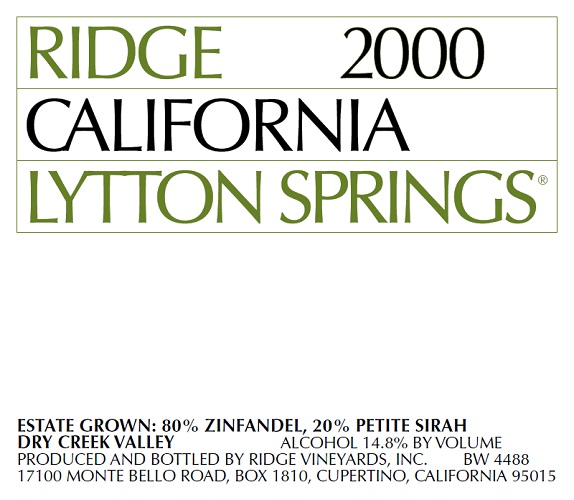
2000 Lytton Springs
Wine Information
80% Zinfandel, 20% Petite Sirah
Vintage
2000
Vineyard
Lytton Springs
Appellation
Dry Creek Valley
Alcohol By Volume
14.8%
Vintage Notes
This year, set (fruit formation) was down significantly, but these low yields allowed the grapes to ripen fully by mid-September; we were able to harvest all of Lytton Springs in just two weeks. The eighteen separate parcels—divided among thirty-four small fermentors—fermented on their natural yeast. We chose seventy percent of the most intense and flavorful lots for this wine. For the first time in a decade, all were either zinfandel or petite sirah. (The carignane, mataro, and softer zinfandels will be part of our Sonoma Zinfandel.) A third of the air-dried american oak barrels used in aging were either new or one year old, so to accentuate the fruit, and avoid over-oaking, we bottled after twelve months. This very rich, yet well-structured wine is appealing now; its lovely fruit will show to best advantage over the next five to seven years. PD (10/01)
History
We made our first wine from this historic vineyard in 1972. Located on the benchland and rolling hills between Dry Creek and Alexander Valleys, it is just north of Healdsburg, in Sonoma County. Today Lytton East and West, purchased by Ridge in the early nineties, are separated by several small residential parcels. In the 1870s, under “Captain” William Litton’s ownership, they were part of one property; the spelling evolved into “Lytton” by 1903. The vineyard is planted primarily to zinfandel and its principal complementary varietals: they include petite sirah, carignane, a small amount of mataro (mourvèdre), and century-old grenache. After years of including “zinfandel” in a prominent position on the front label, we ceased to use it in 1993, instead placing focus on the distinctive character of the site itself. The timing of flowering was typical this year, but set was significantly smaller than usual.
Summer temperatures fluctuated rather wildly. With less fruit to ripen, however, harvest began in mid- September and was over in only two weeks. We fully crushed most of the zinfandel. The petite sirah, and the very intense, small-berry zinfandel from the eastern hills was de-stemmed, a majority left as whole berries. Tannins were considerable in this latter group: leaving the berries whole, and using the floating cap method of fermentation (rather than submerged cap, which we used with the fully-crushed fruit) enabled us to better guide tannin extraction. It also meant we could extend maceration (time on the skins and seeds) to an average of twelve days—more typical of Ridge winemaking in the seventies and eighties than the nineties. Both primary and secondary (malolactic) fermentations were uninoculated, depending instead on the natural process and the yeasts present in the vineyard. We divided fruit from the eighteen individual vineyard parcels among thirty-four fermentors, and chose seventy percent of these wines for the 2000 Lytton Springs. (The remaining thirty percent, softer and less structured) were included in our Sonoma Zinfandel.) This year we did not use the carignane and mataro. The dominance of zinfandel and petite sirah is, again, more characteristic of wines from the seventies and eighties. Twenty percent of the wine aged in new, air-dried american oak, and another ten percent in still-strongly-flavored one-year-old oak. Based on regular evaluative tastings, we elected to bottle after just twelve months. This a rich, complex, sensuous wine. Approachable now, it will continue to develop over time.
Consumer Tasting Notes
Average Rating: 89.2
No. of Tasting Notes: 67
View this wine on CellarTracker
Vintage Tracker
See how this and other vintages of Lytton Springs are drinking today:
Food Pairings
See all food pairing recipes we have created specifically for this wine.
See pairingsWait!
In order to qualify for user related discounts, you must log in before proceeding with checkout. Click the button below to log in and receive these benefits, or close the window to continue.
Log In